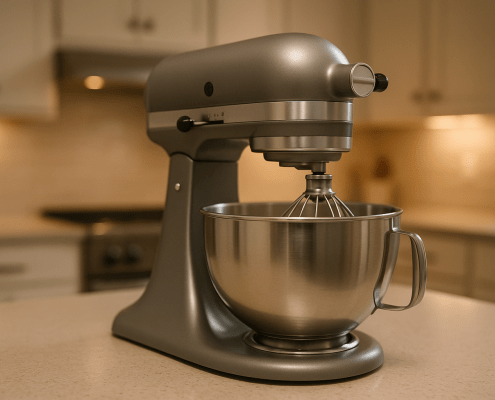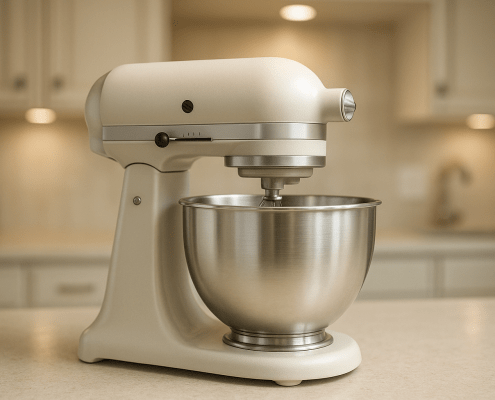How to Fix a KitchenAid Stand Mixer Case Leaking Grease
Steven E / Thursday July 10, 2025
Noticed some sticky grease or oil dripping down from the head of your KitchenAid stand mixer? Don’t worry, it’s a common issue that just means your mixer could use a little maintenance. Here’s how to troubleshoot and fix a KitchenAid mixer leaking grease so it stays clean, quiet, and running like new.
The information in this article may not apply to your specific appliance model. We recommend consulting your manufacturer’s documentation or contact us with any questions.
Why Is My KitchenAid Mixer Leaking Grease?
Inside every KitchenAid stand mixer is a set of gears packed with food-safe grease. This grease lubricates the gears, absorbs heat, and ensures smooth operation. Over time, though, the grease can degrade.
Here’s why you’re seeing leaks:
- Age and wear: As the mixer ages, the grease can separate into oil and thick solids. The thin oil may seep out around the planetary hub or drip into your bowl.
- Heat and overuse: If you run your mixer for long periods or overload it, the gearbox gets hot, which can cause the grease to liquefy and leak.
- Storage: If your mixer sits unused for months, the grease can separate on its own, especially in warm environments.
Tools and Supplies You’ll Need
Before you start, gather the following:
- Phillips and flathead screwdrivers.
- Needle-nose pliers or a small pick.
- Food-safe grease
- Plastic scraper or putty knife.
- Clean rags or paper towels.
- Soft brush (optional).
Step 1: Safety First
Unplug the mixer from the outlet. You’ll be removing the motor housing and accessing internal parts, so make sure it’s completely powered down.
Step 2: Remove the Planetary Assembly
- Turn the mixer upside down on a towel.
- Use a small flathead screwdriver or pick to remove the retaining pin from the planetary hub (the round, spinning part at the bottom of the head).
- Gently wiggle and pull the planetary assembly downward and off the shaft.
- Set it aside.
Step 3: Remove the Motor Housing Cover
- Unscrew the rear cover on the back of the mixer and set it aside.
- Remove the screws along the sides and top of the mixer head.
- Carefully lift off the motor housing cover to expose the gears.
Step 4: Inspect the Gearbox and Grease
Now you can see the heart of your mixer, the gearbox full of grease. Look for:
- Dark, gritty, or clumpy grease.
- Clear or yellowish oil that has separated from the grease.
- Dry spots where the gears are no longer coated.
If you see these signs, your grease has broken down and needs to be replaced.
Step 5: Clean Out the Old Grease
- Use a plastic scraper or putty knife to carefully remove as much old grease as possible.
- Wipe down the gears, gearbox walls, and surrounding parts with a clean rag or paper towel.
- For stubborn bits, use a soft brush to dislodge debris.
Take your time here; the cleaner the gears, the better the new grease will perform.
Step 6: Pack With New Grease
Once clean, it’s time to re-grease the gears.
- Scoop a generous amount of food-safe grease onto a clean scraper or gloved finger.
- Pack it evenly around all the gears and moving parts in the gearbox.
- Make sure every gear tooth is coated, but don’t overfill; about 90% full is ideal.
Step 7: Reassemble the Mixer
- Replace the motor housing cover and tighten the screws.
- Slide the planetary assembly back onto the shaft, aligning it properly.
- Reinsert the retaining pin and secure it in place.
- Reattach the rear cover.
Step 8: Test Your Mixer
Plug the mixer back in and turn it on. Run it at low, medium, and high speeds for a few seconds each. You should hear a smooth hum, and there should be no more grease leaking from the planetary hub.
How to Prevent Future Leaks
Now that your mixer is freshly greased, keep it in top condition with these tips:
- Run your mixer at the correct speed for the task, don’t overload it.
- Wipe down the planetary hub after every use to catch any minor seepage.
- Store the mixer in a cool, dry place.
- Repack the grease every 3–5 years, depending on use.
Where To Find Us
If you need any replacement parts for your appliances, you can enter your model number at AppliancePartsPros.com to locate and order them quickly. Most orders arrive in just two business days, and we have tons of great information in our repair help section and YouTube videos to help you troubleshoot.
Stay connected with the latest DIY tips, tutorial videos, and repair guides by following us on Facebook, Instagram, and Twitter. We love hearing about your repair stories and successes. If you need more help or want personalized guidance, feel free to reach out. We’re ready to help you take on your next project with confidence!
With nearly a decade of experience in providing top-notch customer service regarding appliance parts and repair, Steven enjoys sharing practical advice, troubleshooting tips, and interesting information to help readers stay informed.





